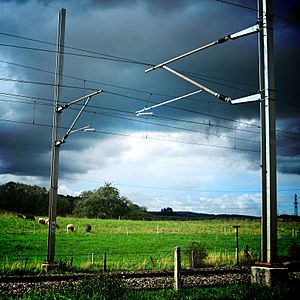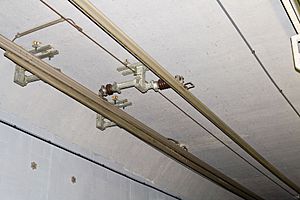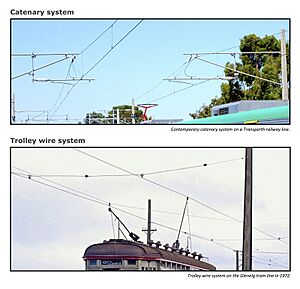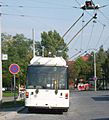Overhead lines facts for kids

Overhead lines or overhead wires are special wires placed above trams, trolleybuses, and trains. They are used to give these vehicles electrical energy so they can move. Think of them like a giant, continuous power cord that stretches for miles, keeping the vehicles running without needing to carry heavy batteries.
Contents
How Do Overhead Lines Work?
Overhead lines deliver electricity from a power station to the moving vehicle. Trains and trams use a device called a pantograph, which is a frame on the roof that slides along the overhead wire. Trolleybuses use a trolley pole, which is a long pole with a small wheel or shoe at the end that touches the wire. Both the pantograph and the trolley pole collect electricity from the wire and send it to the vehicle's motors, making it go.
Why Use Overhead Lines?
Using overhead lines is a very efficient way to power public transport. Here's why:
- Continuous Power: Vehicles get a constant supply of electricity. This means they don't need to stop and recharge like battery-powered vehicles.
- No Emissions: The electricity comes from a power station, which can be far away. This means the trains, trams, and trolleybuses themselves don't produce harmful exhaust fumes in cities.
- Less Weight: Vehicles don't need to carry heavy batteries or fuel tanks, which makes them lighter and more efficient.
Types of Overhead Lines
There are a few main types of overhead line systems, each designed for different kinds of vehicles and speeds:
Catenary Systems
A catenary system is often used for high-speed trains. It uses a main support wire, called a messenger wire, from which the contact wire hangs. The contact wire is the one the pantograph actually touches. This design makes the contact wire very stable and smooth, even at high speeds. It helps the pantograph maintain good contact, which is important for fast trains.
Trolley Wire Systems
Trolley wire systems are simpler and usually used for slower vehicles like trams and trolleybuses. In this system, the contact wire is often held up directly by hangers from poles or structures. It's less complex than a catenary system and works well for vehicles that don't travel at very high speeds.
Overhead Conductor Rails
Some older or special systems use an overhead conductor rail instead of a wire. This is a rigid metal bar that carries the electricity. It's less common but can be found in places like tunnels where there might be less space for wires. The Baltimore Belt Line in the USA used this type of system in 1901 because of its many tunnels.
Safety and Maintenance
Overhead lines carry very high voltages of electricity, so they are extremely dangerous. Only trained professionals, called lineworkers, are allowed to work on them. They use special vehicles and equipment to repair or maintain the lines, ensuring they are safe and working correctly. Sometimes, parts of the line need to be tensioned to keep them tight, or switches are used to guide the pantograph or trolley pole from one wire to another, especially where tracks or routes split.
Related pages
Images for kids
-
Overhead over a switch in Toronto: Two runners for pantographs flank the trolley pole frog.
-
A swing bridge near Meppel, the Netherlands. There is no overhead line on the bridge; the train coasts through with raised pantograph.
-
B&O's overhead third-rail system at Guilford Avenue in Baltimore, 1901, part of the Baltimore Belt Line. The central position of the overhead conductors was dictated by the many tunnels on the line: the ∩-shaped rails were located at the highest point in the roof to give the most clearance.
-
An older rail bridge in Berwick-upon-Tweed, retrofitted to include overhead catenary lines
-
Gantry with old and new suspended equipment at Grivita railway station, Bucharest.
See also
 In Spanish: Catenaria (ferrocarril) para niños
In Spanish: Catenaria (ferrocarril) para niños


















